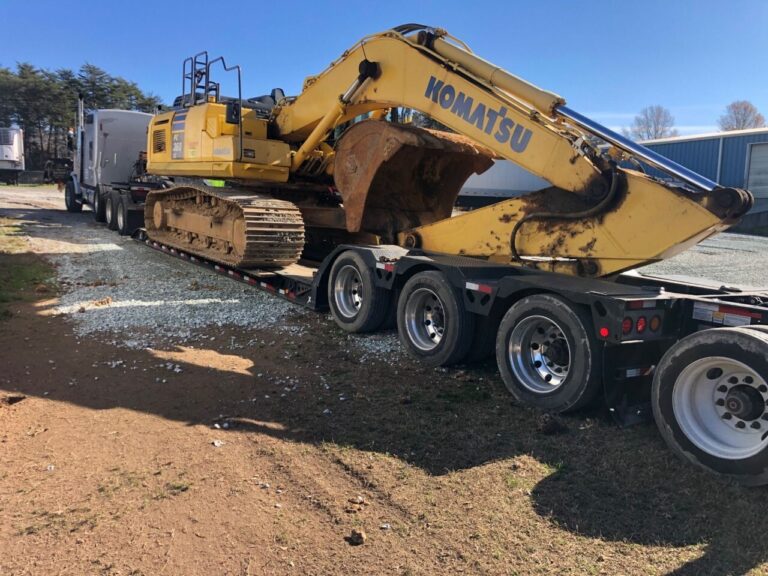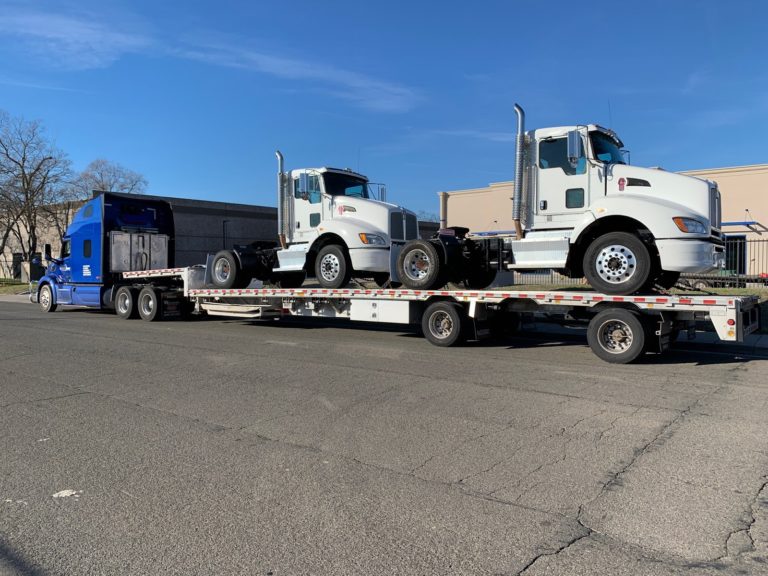Wideload Transport, Part 1: Is Your Load Oversize?
If at all possible, you want your heavy equipment transport to fit within the dimensional requirements for commercial vehicles. You must satisfy those requirements in all the states in which your cargo is travelling.
Satisfying dimensional requirements saves you money. Wideload transportation is expensive, maybe 10 times more than regular transport. You’ll need special trailers, plus extra route planning, scheduling and escort car services. Avoid any oversize designation if you can.
Each state sets its own rules for loads on commercial vehicles that exceed federal dimension regulations. State wideload regulations take into consideration the state’s infrastructure and traffic patterns. States issue oversize load permits, not the federal government.
Yes, with all the conflicting rules it can get confusing. Your equipment transportation broker has access to up-to-date rules and regulations for each state. Experience counts when shipping oversize loads. Ask your agent to help you plan and execute any oversize load shipment.

Federal Rules for Commercial Vehicles
The Department of Transportation’s Federal Highway Administration (FHA) sets dimension regulations for commercial vehicles that travel on the interstate highway system. On some rules, FHA let’s each state decide. Federal rules apply in most states, but you’ll have to check because exceptions occur.
FHA establishes maximum limits for weight and width, and minimum limits for length. States handle maximum length limits and maximum height limits.
Some states have “grandfather rights” that allows the state to adjust FHA dimensional limits.
What are grandfather rights? Also called “acquired rights,” grandfather rights allow an old rule to apply in certain situations that are stipulated in the new rule. Most grandfather rights involving commercial vehicle regulations date before 1975, when many of the current dimension rules were implemented.
FHA outlawed states from regulating trailer length in 1982. But any maximum length regulations regarding trailers were grandfathered on that date. A maximum length of 65 feet was established in 1991. In effect, FHA is telling states they can’t change their maximum trailer length to anything other than 65 feet.
You’ll have to check with your shipping agent to determine whether rules have been adjusted in the states in which your cargo is traveling. Another option: Check the state regulations yourself. Just search for the state highway administration you need, they click on the link for oversize cargo transport regulations.

Legal Dimensions for Commercial Vehicles
The best way to determine your equipment’s dimensions is to measure it. Maybe you’ve added bigger tires, or a new attachment, to the stock machinery you purchased. You can look up the specifications online or in the product manual, but you’re better off measuring the height, length and width of your equipment yourself.
You’ll have to estimate the weight of your equipment using the manufacturer’s specs. Look up the specs in the owner’s manual or online. Your transport agent can help you with specs based upon the model name and number. But there’s no replacement for measuring the crucial elements – height, width and length – yourself. Measure twice, ship once.
Legal Weight for Commercial Vehicles
FHA weight limits apply to interstate highways, as well as other roads that are part of the National Network of highways. The standard maximum weight for commercial vehicles as prescribed by FHA are as follows:
- 80,000 pounds gross vehicle weight.
- 20,000 pounds single axle weight.
- 34,000 pounds tandem axle weight.
However, 38 states have some type of grandfathered weight restriction that is different from FHA rules. Twenty-eight states have grandfathered weight restrictions on non-interstate highways that are higher the FHA rules. Those grandfathered restrictions range between 88,000 pounds max in Hawaii to 164,000 pounds max in Michigan.
The 80,000 pounds gross vehicle weight is the accepted standard. In general, the tractor-trailer rig itself weighs in around 40,000 pounds. Your goal is to distribute properly the remaining 40,000 pounds of cargo between at least two trailer axles. Each piece of equipment is configured differently, so you’ll need to provide exact dimensions to your transportation agent.
Legal Width for Commercial Vehicles
FHA has set the maximum width limit at 8 feet 6 inches. All states conform to this standard, except Hawaii. In Hawaii, the maximum width is 9 feet (108 inches). Everywhere else, the width limit is 102 inches.
Width is measured from side to side. Since most trailers are 8 feet 6 inches wide, your cargo can’t extend over the side of the trailer. Don’t include safety equipment, mirrors or reflectors, in your width calculations.
Legal Length for Commercial Vehicles
FHA says states can’t limit the length of a tractor-trailer to less than 48 feet, unless their limits are protected by grandfather rights. Most states have settled on 65 feet as the maximum total length. Almost all state length limits are between 53 feet and 75 feet. Only Georgia, at 100 feet, is longer.
Four states (Mississippi, Rhode Island, South Dakota, Wyoming) limit trailer length instead of overall length. In many states, length calculations include any overhang where the load extends past the end of the trailer. Make sure you ask your shipping agent how the states in which your cargo will travel calculate commercial vehicle length.
Width is measured from side to side. Since most trailers are 8 feet 6 inches wide, your cargo can’t extend over the side of the trailer. Don’t include safety equipment, mirrors or reflectors, in your width calculations.
Legal Length for Commercial Vehicles
FHA says states can’t limit the length of a tractor-trailer to less than 48 feet, unless their limits are protected by grandfather rights. Most states have settled on 65 feet as the maximum total length. Almost all state length limits are between 53 feet and 75 feet. Only Georgia, at 100 feet, is longer.
Four states (Mississippi, Rhode Island, South Dakota, Wyoming) limit trailer length instead of overall length. In many states, length calculations include any overhang where the load extends past the end of the trailer. Make sure you ask your shipping agent how the states in which your cargo will travel calculate commercial vehicle length.
Legal Length for Commercial Vehicles
Maximum height limits vary among the states. Most states have settled on 13 feet 6 inches as the maximum allowable height. Some states allow 14 feet in height, and two states (Colorado, Nebraska) stretch that limit to 14 feet 6 inches. Only one state has a taller height limit: Alaska, which has a 15-foot height limit.
Height is measured from the ground to the highest point on the trailer or cargo, excluding lights and antennae. Your transportation agent can provide you with the ground clearance of the trailer on which your equipment ships. To get a proper height estimate, you’ll need to add the height of your equipment to the height of the trailer
Four states (Mississippi, Rhode Island, South Dakota, Wyoming) limit trailer length instead of overall length. In many states, length calculations include any overhang where the load extends past the end of the trailer. Make sure you ask your shipping agent how the states in which your cargo will travel calculate commercial vehicle length.
Get Your Wide load Transport Quote Now!
Step 1: Fill Out Quote Form
Fill out the short & easy quote form.
Step 2: Speak With An Agent
We’ll pick up your heavy equipment or vehicle.
Step 3: Get Transported On Time
We deliver on time so you can get back to work.